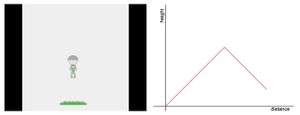How To Draw A Lightbulb In Desmos
Students see graphs in their daily lives, and they sketch and interpret graphs in math classes. But what do they recall graphs represent?
They might call back that unlike looking graphs bear witness different things. Withal teachers know that two graphs that look different tin can correspond the same thing. When teachers focus on the relationships between the attributes included in the graphs, they can assist students to move beyond what graphs await like to what graphs stand for.
When students use graphs to investigate and represent those relationships, they have opportunities to brand more meaning from the graphs. These learning opportunities can make all the deviation.
That's why I worked with Dan Meyer and the squad at Desmos, a gratuitous browser-based awarding, to develop Cannon Human being and other interactive activities. Cannon Man links dynamic animations and graphs in a sequenced, interactive learning experience. Students move through a progression of fourteen screens, which they can complete at their own footstep.
The Cannon Man Learning Experience
Students begin past viewing a video of Cannon Man, who is shot straight upwards into the air and and then falls directly down, with his parachute opening nearly the end of his trip. Subsequently viewing the video, students might discover many dissimilar attributes—the path that Cannon Human being takes, his peak from the ground, his speed earlier and later on his parachute opens. The do directs students to focus on ii attributes in particular: Cannon Man's tiptop from the footing and his total distance traveled (both up and downwardly).

Courtesy of Heather Johnson
The Cannon Human exercise helps students think about how graphs work.
Next, students manipulate dynamic segments to evidence how Cannon Man's height and total distance are irresolute. So they sketch a graph to stand for a relationship between his height and total distance. After sketching the graph, they answer some reflective questions. They repeat this procedure with Cannon Man's elevation and total distance represented on different axes. This gives students the opportunity to apply graphs to stand for relationships between attributes.
To create Cannon Man, I gathered inspiration from dissimilar sources, including existing activities on Desmos such as Part Carnival. A number of researchers inspired my work: Jim Kaput's SimCalc MathWorlds software, Patrick Thompson's theory of quantitative reasoning, Kevin Moore's work with breaking conventions, and Ference Marton's variation theory.
Cannon Man gives students real-time feedback on their work, and teachers can collect student responses. And Cannon Man creates several other opportunities:
Make sense of attributes represented in a graph: If students are going to employ graphs to represent relationships between attributes, they need to make sense of those attributes. To frame the activity, information technology's helpful for teachers to provide opportunities for students to talk over different attributes they notice. The Cannon Man video helps to orient students to the state of affairs and the dissimilar attributes.
Show how they might measure each aspect: It'southward not plenty for students to become familiar with attributes. It'due south also of import for them to recall about how they might measure each attribute. It'due south not necessary for students to come with particular measurements. For instance, they might wonder how they can measure Cannon Man'due south total distance traveled, considering Cannon man does not motion from left to correct. Teachers tin assistance students to call up about distance as the accumulated journey, both up and downward.
Represent how each attribute can change: Graphs represent more than one attribute. Information technology's useful for students to recollect about how each attribute can change. In Cannon Homo, they can use dynamic segments to represent how each attribute can change. And so they can view a computer animation of the dynamic segments.
Use a graph to stand for a relationship between irresolute attributes: One time students have explored private attributes, they can employ a graph to correspond a human relationship betwixt those attributes. It'due south useful for students to move beyond a focus on what graphs look like to a focus on what graphs correspond. In Cannon Man, they tin can use a variety of tools to sketch dissimilar kinds of graphs. They can receive existent-fourth dimension feedback by viewing a dynamic computer sketch of a graph.
Use a different graph to represent the aforementioned relationship: To proceed to investigate relationships between attributes, it's helpful for students to represent relationships in dissimilar ways. Information technology's typical for students to have opportunities to apply unlike types of representations, such as a table or equation instead of a graph. With Cannon Human, students accept opportunities to represent the same relationship with a different graph.
Three Takeaways
How students think about the attributes matters: Requite students opportunities to make meaning of the attributes before representing them in a graph. To promote students' thinking virtually attributes, teachers can ask questions such as: "Can you show me where you see Cannon Man'south distance? How might you measure it?"
Focus on both the whole and the parts: Have students correspond change in private attributes first and and then change in both attributes. To promote students' thinking nearly changing attributes, ask questions such as: "How does moving the dynamic segment right and left testify that Cannon Man'due south height is increasing, then decreasing?"
2 graphs are better than one: Have students utilize more than than 1 graph to show the same relationship. To continue a focus on relationships, teachers can inquire questions such as: "How tin can a single graph show both attributes at the aforementioned fourth dimension?"
Source: https://www.edutopia.org/article/helping-students-see-how-graphs-work
Posted by: juarezazzent.blogspot.com


0 Response to "How To Draw A Lightbulb In Desmos"
Post a Comment